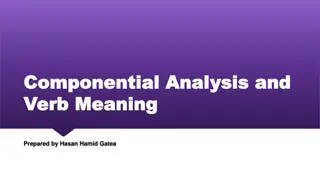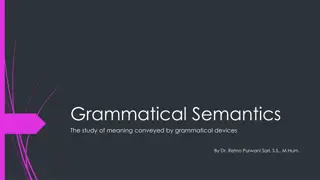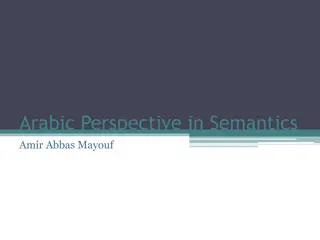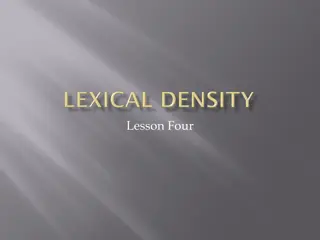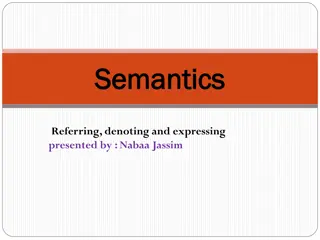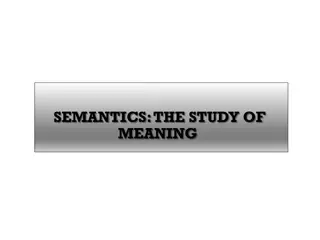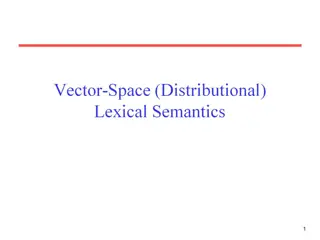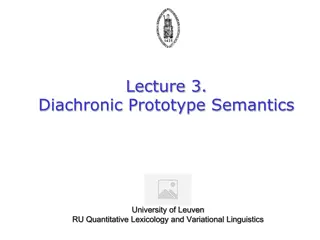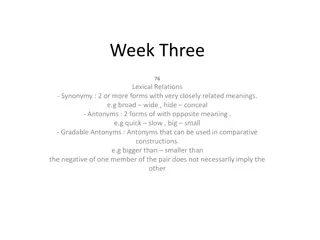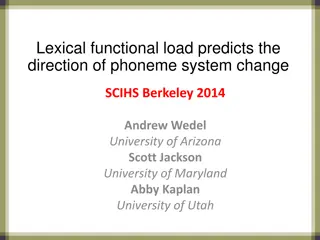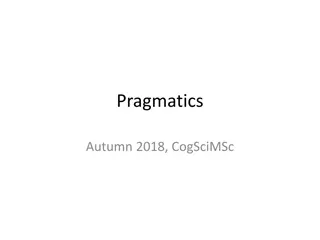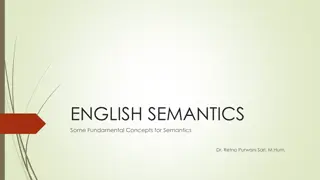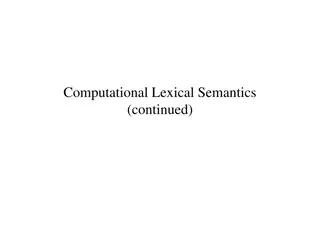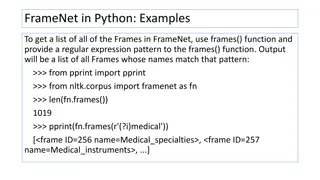Understanding Lexical Semantics: An Overview
Lexical semantics explores the relationships words have with each other and with our understanding of reality. It delves into reference and sense, naming theory, synonymy, and more. Reference focuses on how words relate to objects, while sense deals with relationships between lexical items. Naming theory posits that a proper name's meaning is tied to associated descriptions. Synonyms can vary across dialects, styles, and evaluative meanings. Explore the nuances and complexities of lexical semantics for a deeper insight into language structure.
Download Presentation

Please find below an Image/Link to download the presentation.
The content on the website is provided AS IS for your information and personal use only. It may not be sold, licensed, or shared on other websites without obtaining consent from the author. Download presentation by click this link. If you encounter any issues during the download, it is possible that the publisher has removed the file from their server.
E N D
Presentation Transcript
Lexical semantics Course tutor: Prof. Ahmed Q. Abed, (PhD) Presented by: Aliaa A. Farook
Lexical semantics can be defined as .. - the lexical relation that a word has with others. - lexical semantics aims to answer questions about the nature of words, words content and the relationship between the word content and our construal of reality.
2- types of lexical semantics
2-1 Reference and sense * Reference is concerned with studying the relationship between words inside the linguistic system (referring) and objects in the real world (referent). For example: the word table (referring), we know its meaning in English (reference) and have its mental image in our minds- something that has four legs and a flat surface(referent). reference referring expression referent * Sense refers to the relationship between two lexical items inside the linguistic system. For examples: - Odysseus is intelligent. (give indication about the legend Greek king ). - the meaning of the lexical item is defined by using lexical item that have strong relationships with the word in question such as : the adjective derived from the noun and or its antonym or by the opposite of which is and its synonyms .
Naming theory: naming theory is the view that the meaning or semantic content of a proper name is identical to the descriptions associated with it by speakers, while their referents are determined to be the objects that satisfy these descriptions. Naming theory does not work with abstract words which do not refer to anything in the real world as happiness, sadness, beauty and so on such words have no mental image in our minds, but this does not mean that they are meaningless!!. Other relations between words are whole-part relations as in body and its hyponyms hand, leg, face. Many to one relations as in eye, nose, mouth are hyperonym with body.
2.2 Synonymy Two words are synonymous if substituting one word for the other does not change the meaning of a sentence (Kroeger:2019,108 . Synonymy in English includes verbs ( buy-purchase), adjectives (big- huge), adverbs ( fast-quickly) and nouns (mother-mom) Palmer urges that no two words have exactly the same meaning. Indeed it would seem unlikely that two words with exactly the same meaning would both survive in a language . That leads him to set five ways of differences of synonyms (palmer,1976,60-64) : 2.2.1. different dialects: In American English we have (fall, mall, bookstore, elevator) while in British English we have( autumn, shopping center, bookshop, lift). 2.2.2. different styles and registers: Which indicates the formality (gentleman, terminate) and informality( man, end). 2.2.3. different evaluative meaning: Evaluative meaning is frequently understood as a form of connotation, pertaining to single lexical items . For example: statesman/ politician. 2.2.4. collocation restriction : The term refers to the fact that in certain two-word phrases the meaning of an individual word is restricted to that particular phrase.. For example: we can say fast food but not quick food. 2.2.5. overlapping meaning: Two or more lexes share the same idea, period of time, people ect. For example: to govern to control to direct
Arabic synonyms To translate a semantic repetition form Arabic into English , the translator could follow one of the following strategies suggested by Dickinc et at.(2002:60-61). 1- merging: means the two synonymous words used in the source text into one word in the target text. 2- grammatical transposition: means changing the part of speech of one of the synonymous words used in the source text, such as changing a noun into an adjective, a verb into an adverb . 3- semantic distancing: means translating two synonymous words used in the source text into two words but their meanings are slightly different in the target language. 4-maintenance: it is maintaining the same form of semantic repetition along with the synonyms used. e.x: . *Synonyms or near-synonyms / are merged into one word the poor/happiness. As in the king distributed half of his wealth to the poor, the hypocrites and the gossips. The people lived in happiness. *Or they can be replaced by the English adjective-noun phrase to maintain the general effect of the emphasis provided into the source text. The poor and the needy/ great happiness. the king distributed half of his wealth to the poor, the needy, the hypocrites and the gossips. The people lived in great happiness. *Or they can be maintained as in : the king distributed half of his wealth to the poor, the needy, the hypocrites and the gossips. The people lived in delight and happiness.
2.3 Antonyms Words with opposite meaning. (kroeger,2019:109) Antonyms in both English and Arabic includes adjectives (big -small ) or nouns (man woman ), adverbs ( politely - impolitely ) and adjectives with a comparative and superlative forms (tall short ). Kroeger urges that the term antonym actually covers several different sense relations as complementary, scalar , converse and reverse antonyms : 2.3.1. complementary: is that replacing one member of the pair with the other, as in ( open-shut). 2.3.2. scalar : is that replacing one member of a pair with the other produces sentences which are contrary. Contrary sentences are sentences which cannot both be true though they may both be false as in (my friend is neither extremely diligent nor extremely lazy). Note: Scalar antonyms name values which are relative rather than absolute. E.x. a small elephant will probably be much bigger than a big mosquito, 2.3.3. converse: are words that name an asymmetric relation between two entities (employer-employee), i.e. If we replace one member of a converse pair with the other and also reverse the order of the arguments, we will produce sentences which are semantically equivalent e.g.( X is above Y then Y is under X). 2.3.4. reverse: Two words (normally verbs) are called reverses if they denote motion or change in opposite directions. It is preferred to use again in this type of antonyms. E.g. The nurse heated the instruments to sterilize them, and then cooled them again.( using such pairs of this type allows the using of again which does not mean that the action named by the second verb is repeated but rather that the situation is restored to its original state).
2.4. Polysemy a lexical item which has a range of different meanings.( Crystal 1991:267). single word form is associated with two or several related senses.(Vicente and Falkum,2017) polysemy is pervasive in natural languages, and affects both content and function words. Examples of polysemy : mouse ( small rodent or computer accessory). bright (shinning or intelligent). Arabic like English has a lot of examples of polysemous words. As in Root either the part of plant or the root of hair or tooth, soap as a substance used by people for washing their bodies or a kneecap which is a bone that covers the front of the knee. ) ' 71 People of the Book! Why do you confound the truth with vanity, and conceal the truth and that wittingly (Arberry 1955/1996) Here, the polysemous word is from the verb or cover somebody with clothes. However, in this verse, it is used by Allah while addressing the people of the Torah and Bible to mean to mix or to mingle the truth with falseness. - - which literally means to dress somebody , /
References : Almanaa, A. (2016) . Semantics for translation students. Peter Lang. Crystal,David.(1991) .A dictionary of linguistics and phonetics.3rd edn. Oxford Blackwell. Kroeger,P.R.(2019).Analyzing meaning,2nded. Language Science Press . Remirez,M. Universidad del Pais Vasco. Spain. https://www.researchgate.net/publication/288875882_Evaluative_M eaning_in_Translation https://en.wikipedia.org/wiki/Collocational_restriction


